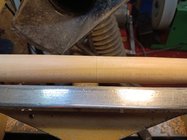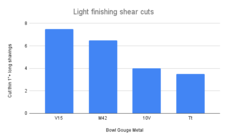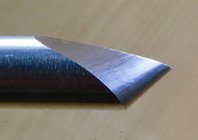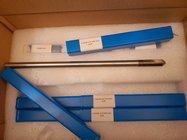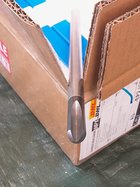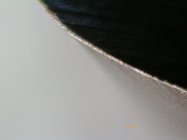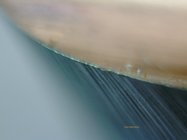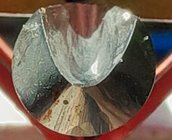I was just making the point that according to that document, grinding with a finer grit can produce a better finish. This photographic evidence seems to contradict what some others have observed?Bill
What needs to be added to those images is the grit sizes that Lacer & Wright used for their experiments, which can be read starting on
Pg58 of their articles you linked to.
The first tool edge image in each sequence is off a #60 wheel. The second is off a #600 diamond 'hone'.
However, if you were to refresh the edge of a tool on a #600 or #1,000 wheel are you grinding or honing it. The term 'hone' had more meaning back when grinding stones were always a coarser grit than hand honing stones. With grinding wheels available now going up to #1,000 or more the term 'hone' has a less precise meaning.
This is not a criticism of the Lacer & Wright article, which is an excellent piece of work at the time they conducted it. What we can take from their article is that grit size makes a difference and as long as you nominate the grit size you are referring to you can call the process whatever you like. I have several devices that I call hones and all they do is 'sharpen' to a finer grit or micron size. It's all just 'sharpening' along a grit continuum.
-
We just finished moving the forums to a new hosting server. It looks like everything is functioning correctly but if you find a problem please report it in the Forum Technical Support Forum (click here) or email us at forum_moderator AT aawforum.org. Thanks! -
Beware of Counterfeit Woodturning Tools (click here for details) -
Johnathan Silwones is starting a new AAW chapter, Southern Alleghenies Woodturners, in Johnstown, PA. (click here for details) -
Congratulations to Dave Roberts for "2 Hats" being selected as Turning of the Week for April 22, 2024 (click here for details) -
Welcome new registering member. Your username must be your real First and Last name (for example: John Doe). "Screen names" and "handles" are not allowed and your registration will be deleted if you don't use your real name. Also, do not use all caps nor all lower case.
You are using an out of date browser. It may not display this or other websites correctly.
You should upgrade or use an alternative browser.
You should upgrade or use an alternative browser.
Is there any difference between...
- Thread starter odie
- Start date
john lucas
AAW Forum Expert
I just did two more tests. Last night I turned a somewhat punky bowl. I made a pass from foot to rim with my 40 degree gouge. It had been sharpened on a 350 grit CBN wheel. Then I sharpened it on a 36 grit blue AOX wheel. Made another pass from foit to rim trying to reproduce the same thickness and speed of travel. I could not see the difference. I'm trying to push the tool 9nly as fast as the wood wants to be cut.
This morning I did another test. Took a maple spindle. Turned it with my Thompson skew sharpened on my 350 wheel then honed with a 1200 grit diamond hone and then stopped on my Tormek. Then I made another pass half way across with the tool sharpened on the 36 grit AOX wheel. Did not even remove the burr. Hard to tell from a photo but there is no difference. The right side of the spindle is the course grind the left side is the fine grind.
This morning I did another test. Took a maple spindle. Turned it with my Thompson skew sharpened on my 350 wheel then honed with a 1200 grit diamond hone and then stopped on my Tormek. Then I made another pass half way across with the tool sharpened on the 36 grit AOX wheel. Did not even remove the burr. Hard to tell from a photo but there is no difference. The right side of the spindle is the course grind the left side is the fine grind.
Attachments
I may rant about my own discoveries in woodturning, but I ultimately do subscribe to the philosophy of "I'm OK, and you're OK"! If someone else is good with their results on the lathe, then that's fine with me, and accept it.
However, from my observations I've noticed that quite a few turners are satisfied with a tooled finish that requires aggressive sanding to get rid of the torn end grain, uneven surfaces, and tool marks. For those who embellish their turnings, this may be perfectly acceptable because they rely on sanding to eliminate what they consider inconsequential flaws......but, for my kind of turning, where the subliminal attraction relies on perfect geometry to gain the desired aesthetic appeal, it's not acceptable. In order to maintain the perfect geometry, then the turning skills, along with the right tools and techniques are essential to have a tooled surface in preparation for a very minimal amount of sanding. Aggressive sanding of bowls, being that they are side grain orientation, and the resistance to sanding alternates as it spins on the lathe, means the geometric integrity suffers a loss of perfection.....or, roundness. This loss of geometric integrity is what destroys the ability to achieve the aesthetic appeal my turnings rely on for visual acceptance by those who purchase them. They may not know just what it takes to gain their approval, but they know what they like, and most, if not all of them have seen or purchased turnings from other turners prior to making their comparisons and judgements.
^^^^^None of this will make much difference to many other turners, but for a select few, these things are essential.
-o-
Good post, Odie. I'm still in the stage where I am doing a lot of sanding. I'll keep working on it.
I have not read this whole thread. Way too long but I might try. I did my own tests. I ground high carbon steel , m2 steel and A11 particle metal to 2000 grit. Then honed them further. Then viewed them under an electronic microscope. I forget the magnification but it was very high. All 3 metals sharpened to the same sized peaks. Then I tested them on a commercial sharpness tester. All tested very close to identical.
However the test I'm doing right now shows me that for turning tools how polished the edge is barely matters. I know I'll take some flak over this but I've spent the last week turning all kinds of wood with various tools. I sharpen the tool on a 36 grit AO wheel. Make a cut. Then sharpen on my 350 cbn wheel. In most cases I cannot see the difference in the cuts. It us important to not cut the wood any faster than the wood wants to be cut. I use a very short main bevel so I can feel the cut. This travel rate us slower than you might think but that makes far more difference in the cut than the grit you sharpen with. Testing still going on.
I wonder how much steel is removed at 80 grit vs. 320. Will your tools last twice as long (over time) if you sharpen at 320? Inquiring minds.
odie
TOTW Team
- Joined
- Dec 22, 2006
- Messages
- 7,116
- Likes
- 9,837
It is important to not cut the wood any faster than the wood wants to be cut. I use a very short main bevel so I can feel the cut. This travel rate us slower than you might think but that makes far more difference in the cut than the grit you sharpen with.
A very important point. ^^^^^
-o-
Good point.I wonder how much steel is removed at 80 grit vs. 320. Will your tools last twice as long (over time) if you sharpen at 320? Inquiring minds.
I’ve just started using a Burnisher on my scrapers to form the burr and read you could go back to it two or three times before needing to go back to the grinder. This certainly seems to be the case so far but it’s early days with the process for me.
Neil-I know that the Thompson flutes are a bit rougher than other manufacturers' inner flutes. I only have 1 DT bowl gouge. In your experience, do the other makers need this polishing? Carter and Sons? D-Way? Both seem pretty smooth to me.
Neil, with your testing of edges, you get some interesting results. I don't have the machines to actually test hardness or edge retention, or to greatly enlarge the edge for close up inspection. With the tantung, I have found that I can turn for a couple of hours without needing to go back to the grinder. I am only using it as a scraper though. As for the use of M42 and V10, I have not been able to notice any difference in edge retention/durability, and this is after 10+ years of using those metals. One good friend and mentor, who turned myrtle trays for the coastal shops here said he couldn't tell any difference either. He did 700+ of them each year for 30 or so years. With the differences you show, I would expect to be able to feel some noticeable differences. No clue as to why....
One thing I have wanted to try some time, is to make a skew out of the tantung. It would have to be sandwiched in between some softer metal, but still not sure if it would work because of how brittle the tantung is.
Also, there is a difference between honing and stropping. Honing creates a burr, and I have found this to be consistent with grits above 10000 grit. Stropping removes the burr.
robo hippy
One thing I have wanted to try some time, is to make a skew out of the tantung. It would have to be sandwiched in between some softer metal, but still not sure if it would work because of how brittle the tantung is.
Also, there is a difference between honing and stropping. Honing creates a burr, and I have found this to be consistent with grits above 10000 grit. Stropping removes the burr.
robo hippy
Last edited:
Bill-I'm a good deal more knowledgeable on scrapers, as that has been my go-to stop-gap while I was/am getting better at shear-scraping and finer finishing cuts with my bowl gouges. I will grind a good burr on my scrapers, then probably pull it up again with a carbide rod at least 12-15 times before I hit the grinder again (though I don't count-I just re-grind when it starts producing more dust than fine shavings, which means it's not cutting). I'm pretty aggressive with the rod (it helps to have it mounted in a good handle where you can really put some leverage on it) , and sometimes will refresh after every pass, as I like a nice fine cutting/shear-scraping action.Good point.
I’ve just started using a Burnisher on my scrapers to form the burr and read you could go back to it two or three times before needing to go back to the grinder. This certainly seems to be the case so far but it’s early days with the process for me.
And since I've started really watching Tom Wirsing's videos and attempting to imitate his platter designs, I now see the scraper as a much more legit finishing tool. He scrapes every surface with a negative rake scraper and needs very minimal sanding to finish. And he doesn't power-sand AT ALL. I really look forward to his demo at our CMW this fall.
I was just making the point that according to that document, grinding with a finer grit can produce a better finish. This photographic evidence seems to contradict what some others have observed?
Yes, John Lucas got different results to that of Lacer & Wright.
Both have given the details of their methodology.
The only immediate difference in the reported methodology that I can see is that Lacer & Wright took 200x magnified images of the surface finish John has reported on how he saw the finish and how much sanding he thought the piece needed.
The other thing to note is that Lacer & Wright didn't specify the area of woodgrain that was photographed, whereas John said he focussed on the end grain areas, which we know are the problematic areas for finish off the tool with cross grain work.
I spend a lot of time looking at cutting edges under magnification and know the benefit of doing that, but I'm not sure how valuable it is to see the wood surface finish at x200 magnification.
The other unknown variable is the 'feed rate' that Lacer & Wright used with the bowl gouge experiments. If they were like me it would have been as fast as possible, whereas John has indicated that he only cuts as fast as he thinks the tool will do a good job with the surface finish.
Last edited:
Neil-I know that the Thompson flutes are a bit rougher than other manufacturers' inner flutes. I only have 1 DT bowl gouge. In your experience, do the other makers need this polishing? Carter and Sons? D-Way? Both seem pretty smooth to me.
I haven't used any Carter & Sons, but have quite a few D-Way gouges and they have all come with nicely polished flutes.
Doug Thompson makes an excellent gouge for the price and in my opinion they are worth any extra effort to fine grind and polish the flutes on them.
You can also re-profile the flute on a Thompson, or any other gouge, to another flute profile that you need or might like to try. Turners endlessly play with their bevel grinds but seem to be reluctant to do the same with flutes. The reason we now have different flute profiles options available is that toolmakers, often in association with well known turners at the time, have played around with different possibilities before settling on a design. Why let them have all of the fun? You may be the next Glaser or Child to give us what we didn't know we were waiting for...
If Richard Raffan uses two bevel grinds on the one gouge, one for turning the outside of bowls and the other for the inside, why not different profiles for each side of the flute?
As for the use of M42 and V10, I have not been able to notice any difference in edge retention/durability, and this is after 10+ years of using those metals. One good friend and mentor, who turned myrtle trays for the coastal shops here said he couldn't tell any difference either. He did 700+ of them each year for 30 or so years. With the differences you show, I would expect to be able to feel some noticeable differences. No clue as to why....
I'd be just guessing why you and your friend with so much experience between you may not have noticed any difference between M42 and V10.
If like me you sharpen up half a dozen bowl gouge of mixed heritage together and then turn with each one until it is blunt, then move onto the next one until they are all blunt before going back to the grinder to resharpen them all in a batch, you don't get a good sense of just how long the edge is lasting on each one. You know when you get to the point when it is no longer cutting well enough for you in the wood your turning, but not how long it took to get there. Well, I didn't.
I would often reply when asked which makes or steels are the best and I would reply that they are all very similar and if you buy any one of the well known brands you won't go too far wrong.
Then about 15yrs ago when I got some of Doug Thompson's V10 and V15 tools I noticing an difference between those in use and after having a discussion with him about that I became more interested in the different tool steels and began to do more systematic testing when I got new tools to measure what, if any, were the differences.
About 3yrs later I got my first gouge from Dave Schweitzer and did a Thompson 10V vs D-Way M42 side-by-side gouge test run and posted my results, which upset a few people including Dave. Whenever i have repeated that test and included the M42 the results have always come back the same since then, so I'm confident about that. The M42 doesn't have the endurance of V10 with heavier cuts, but where the finer carbides in the M42 excel is its keen edge when freshly re-sharpened and the very fine finishing cuts that it can do for longer than the V10.
There is of course some subjectivity in whether a gouge is still cutting well enough for you or needs to be re-sharpened. To eliminate the subjectivity during my testing I turn until the edge won't cut any more. That isn't how most of us turn, but it does give a measure of how long the edge on a particular tool steel will cut in a given wood compared to other tool steels and that then gives a relative measure back from which each of our preferred 'it's time to re-sharpen' point is likely to be.
I'm not sure if any of this explains why you and your good friend haven't found any difference between the V10 and M42. Perhaps both of you resharpens well before the V10 would cut past where the M42 would give up.
Well, I don't ever turn till the tool won't cut any more, or had difficulty cutting. I would think I get to about 75% of what a fresh edge is and then sharpen, though I have no way to measure that. On bowls I do all of my roughing with the Big Ugly tool, as did my friend. The big thing in kitchen knife sharpening is some cutting jig that measures now much pressure it takes to cut through a thread. I think a straight razor is in the 100 or less grams and a butter knife is 1000 or more grams, can't remember. That could make for an interesting test. Not sure if it would clear things up or not.... Not sure if it would be possible to test a gouge other than with the nose of the gouge rather than the 2 wings....
robo hippy
robo hippy
Reed-I have refined many a straight razor edge for shaving. It's not quantifiable, really, but the "hanging hair test" is used by many of us. Hold a piece of hair out, and if the razor will cut it clean, especially if it will do it without resistance, it will probably give a smooth shave. My favorite test is if it will "tree-top" mow arm hair effortlessly, I can usually count on a very smooth shave. This is often obtained on a 12k waters-tone as the final synthetic in a progression followed by super-fine work on whatever natural stones ones favors for smoothness (German thuringians, surgical black Arkansas, Japanes naturals, coticules, and many others-this is the real fun IMO). Then of course I run mine across my rack of vintage strops, finishing on the cordovan. The finest vintage razor steels were from Solingen, Sheffield and Sweden. Of course the custom makers nowadays are playing around with other steels, hammering damsascus, and all sorts of experimenting going on. Razors are a whole other sharpness obsession!
Shaving is one unnatural act that I won't do....
robo hippy
robo hippy
Reed, I watched one of your YouTube videos some years ago using the big ugly. Just how sharp can you get that material and is it easy to sharpen, I use a belt grinder.
The tangung sharpens easily on standard grinding wheels, and on CBN wheels also. I have honed it down to a fine edge, and I can get very clean surfaces when I use it like a skew. I think I have an easier time with it when I use it like a skew than I do with an actual skew. I don't know if I can get it as sharp as an M2 HSS tool though.
robo hippy
robo hippy
I have both Carter and DT flutes and find the DT steel is harder and holds an edge much longer. It’s my go to brand. And no, I don’t get paid for my opinion.Neil-I know that the Thompson flutes are a bit rougher than other manufacturers' inner flutes. I only have 1 DT bowl gouge. In your experience, do the other makers need this polishing? Carter and Sons? D-Way? Both seem pretty smooth to me.
I have both Carter and DT flutes and find the DT steel is harder and holds an edge much longer. It’s my go to brand. And no, I don’t get paid for my opinion.
Tim
My test results (see post #28) showed that M42 (as used by Carter and others) does not hold its edge as well as V10 doing heavy cuts, but for light finishing cuts the finer carbides in the M42 do better. V15 is a better all-round performer, but is expensive and currently not available from any of the makers, but Stuart Batty is indicating that he is planning on bringing out his gouge in V15 https://stuartbattytools.com/home
Tantung sits between V15 and V10 on edge durability for doing heavy cuts, but it's large carbides don't perform well at all on light finishing cuts. It is also very chippy on fine gouge edges and also difficult to source and very expensive as a base stock. Typically it is chill cast that adds considerably to its cost, although I and a colleague have ground some test gouges from round bar stock to see if it was worth pursuing. We don't think it is for gouges, but brazing a flat strip of Tantung to a bar is a far less expensive process and a good option for doing heavy scraping cuts if that is the way you like to turn.
The next step up from those steels is TC that is used by some turners in the form of small tips mounted on shafts and mostly used in scraping mode. Some also use cupped TC tips that can be used in a cutting mode (bevel rubbing, etc). These tips are typically rotated to present a fresh edge to work with then discarded and replaced when all of the edge is spent.
My colleague ( @hughie ) and I have been developing and testing a traditional bowl gouge made from TC that is nearing production.
Our testing has shown that it outperforms all of the above mentioned high speed steels. One advantage of HSS gouges is that they can all be resharpened on CBN and standard grinding wheels, whereas TC has the additional requirement of needing to be sharpened with diamond. However, we have developed some relatively economical ways of doing this that overcome that as an obstacle to the use of these higher performing TC bowl gouges.
I've had some experience with high production lathes used in spindle turning. Interesting to note they don't use exotic metals in their cutterheads. The cutterheads are designed for extreme shear cutting. Mattison shaping lathes are widely used in spindle turning. Their cutters are described as being "tool steel" for easy grinding.
The video shows a Mattison lathe in action. The cutterhead turns at 2700 rpm and is about 12" diameter. The cutterhead is the length of the spindle and made up of a series of segments.
View: https://www.youtube.com/watch?v=oaEgQDQmot8
In the automatic variety lathe from the 1930's I restored to action years ago the knives were carbon steel (auto leaf springs were a common source) and held up for days of cutting hard maple with occasional honing, never re-grinding. This experience convinced me the shear angles were far more important than the cutter material.
The video shows a Mattison lathe in action. The cutterhead turns at 2700 rpm and is about 12" diameter. The cutterhead is the length of the spindle and made up of a series of segments.
In the automatic variety lathe from the 1930's I restored to action years ago the knives were carbon steel (auto leaf springs were a common source) and held up for days of cutting hard maple with occasional honing, never re-grinding. This experience convinced me the shear angles were far more important than the cutter material.
I would think that if you had 5 of the same size gouges made of 15V, Tantung (never even heard of a gouge made of this),10V, M42 and HSS and all were sharpened on lets say a Tormek with a 1000 grit wheel using everything the same, settings and gear that they would all be the same sharpness. My thought would be that the main difference would be how long they stayed sharp all doing the same cut. In another vein Thomson Tools has in the past made 15V gouges. I have one and I would have to be very careful not to lay it down next to a 10V same size gouge as then I would not know which is which and the difference in using it is not significantly different than using the 10V. As per Doug Thompson the 15V can be chippy.
I have kind of wondered how tantung could be made into a gouge. The thing about the Big Ugly tool is that the tantung, because of how brittle it is, needs support under the primary bevel. I would expect a gouge made from tantung, especially if it is sharpened with a gouge jig, the edges would chip very quickly, which would dull them. The main difference between gouge jigs and platform/hand sharpening is that with the jigs, your wing angles tend to be very acute since you can't roll the tool as much as you can when you free hand sharpen. The platform sharpened tools have a much higher/obtuse angle than jig sharpened tools.
robo hippy
robo hippy
We found that the Tantung wing angled had to be changed to give them greater support in order to prevent chipping.I have kind of wondered how tantung could be made into a gouge. The thing about the Big Ugly tool is that the tantung, because of how brittle it is, needs support under the primary bevel. I would expect a gouge made from tantung, especially if it is sharpened with a gouge jig, the edges would chip very quickly, which would dull them. The main difference between gouge jigs and platform/hand sharpening is that with the jigs, your wing angles tend to be very acute since you can't roll the tool as much as you can when you free hand sharpen. The platform sharpened tools have a much higher/obtuse angle than jig sharpened tools.
robo hippy
So, Hughie, the wing angles were more obtuse then...... I was kind of surprised at how the tantung didn't hold up as well as I expected when turned into a gouge. For sure, it works far longer when I am bowl turning and using the Big Ugly scraper. I would think edge fracturing would make a huge difference in edge retention.
robo hippy
robo hippy
So, Hughie, the wing angles were more obtuse then...... I was kind of surprised at how the tantung didn't hold up as well as I expected when turned into a gouge. For sure, it works far longer when I am bowl turning and using the Big Ugly scraper. I would think edge fracturing would make a huge difference in edge retention.
robo hippy
As indicated by Hughie, we did need to make the wing edges a bit more obtuse to overcome Tantung's tendency to chip if the wing edges were too acute. But, having remedied that the Tantung edge held up very well in comparison to, for example, CPM 10V.
The following magnification images show the CPM 10V edge at the point of exhaustion (ie it would not cut anymore) and the Tantung edge after doing the same amount of cutting on the same very hard piece of wood. In the first image you can see the dull edge on the 10V and why it wasn't able to cut anymore! Whereas, the Tantung edge in the second image was still in relatively good shape after having done the same amount of cutting...
Even if the Tantung were to still chip out a bit from time to time (it didn't after we had changed the edge geometry), it's superior edge retention is a desirable feature in a bowl gouge. As a gouge metal it has some additional benefits like its ability to be sharpened on the grinding wheels currently being used by many woodturners. It also has what feels like lower friction when the bevel is rubbing on the wood... probably from all that cobalt and chromium in it... which is pleasant to use.
Its downside are the cost of the stock material and its manufacturing process. Unlike high alloy HSS that can be machined in the annealed state before being hardening and tampering, Tantung comes out of its metal casting process hardened ready to polish and use. We found that we could grind a short flute into it in that hardened state, but it was hard going. For those reasons it is unlikely to be taken up by any of the current woodturning tool makers because of those disadvantages.
However, there is nothing stop any of you at having a go at making a gouge or two from it yourself...
I have kind of wondered how tantung could be made into a gouge. The thing about the Big Ugly tool is that the tantung, because of how brittle it is, needs support under the primary bevel. I would expect a gouge made from tantung, especially if it is sharpened with a gouge jig, the edges would chip very quickly, which would dull them.
Here is the Tantung gouge tip we made for out test runs...
We ground the bevel to about 42° using a Woodcut gouge jig. Depending on how you present the gouge to the wood, there is still a lot of support behind the edge. We experienced no edge chipping with this flute design and grind. I expect that a thin unsupported strip of Tantung could be very fragile, so brazing that to a steel bar would be necessary in that case.
Stellite is another cutting metal that is not that dissimilar to Tantung, but as yet hasn't been offered commercially as a woodturning gouge for probably the same reasons that we haven't seen one being offered in Tantung.
Having also done some development work now on tungsten carbide bowl gouges I'm convinced that it is a better way to go for durability and performance than Tantung.
I would think that if you had 5 of the same size gouges made of 15V, Tantung (never even heard of a gouge made of this),10V, M42 and HSS and all were sharpened on lets say a Tormek with a 1000 grit wheel using everything the same, settings and gear that they would all be the same sharpness. My thought would be that the main difference would be how long they stayed sharp all doing the same cut.
Yes, Bill, my testing and those reported by others have shown that 15V retains its edge for longer than 10V and 10V about the same difference longer again than M42, as shown on the following graph. If Tantung were added to this graph it would sit close to the bottom right corner and Tungsten carbide would be somewhere off the graph down to the right...
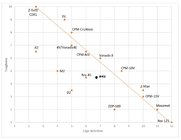
Source: Knifesteelnerds.com
I did have one Big Ugly tool that was made with Stellite. Not sure if it is still in the shop or not. I would say the cutting properties were the same as tantung. It is used on the cutting tips of the Woodcut coring system. There used to be a Hitachi bandsaw that had stellite tips on its cutting teeth. I know there is a manufacturing place in Canada that makes it. They gave me a couple of pieces to play with. When I called back for more, they would only sell me a big chunk of it, and since I had no way to process it, I had to pass.
I am a bit surprised that your tests resulted in a big difference between M42 and V10. When using on the main woods I turn, California Bay Laurel/Oregon myrtle wood, which tends to be abrasive, and Pacific Madrone, which cuts like green pear or dog wood, I can't tell any difference between them as far as edge retention. I don't have microscopes or any close up photo abilities. I just go by how they feel as they cut.
The tantung and stellite can both be honed to a very fine edge. Both can also take a burnished burr. With the tantung though, only very light pressure or the edge chips.
robo hippy
I am a bit surprised that your tests resulted in a big difference between M42 and V10. When using on the main woods I turn, California Bay Laurel/Oregon myrtle wood, which tends to be abrasive, and Pacific Madrone, which cuts like green pear or dog wood, I can't tell any difference between them as far as edge retention. I don't have microscopes or any close up photo abilities. I just go by how they feel as they cut.
The tantung and stellite can both be honed to a very fine edge. Both can also take a burnished burr. With the tantung though, only very light pressure or the edge chips.
robo hippy
OK...let's assume for a second you can achieve a greater level of sharpness with one steel over another. That also means a finer more delicate edge does it not. I'm certainly not a metallurgy guy but it seems that the more delicate the edge the faster it dulls. Also, I think there's a point in turning wood where a tool being super sharp versus super duper sharp is statistically negligible to the wood itself.
Okay, there are all types of exotic tool steels that have different characteristics in sharpness and edge longevity between sharpening, etc, etc, for hand turners. But, what about the production, spindle turning, shaping lathes like I linked to in post # 61 of this thread? Those lathe run all day without needing sharpening with their plain carbon steel knives? How is their lack of downtime for mid-job sharpening explained?
The knives for these types of lathes were designed with shear cutting in mind.
The knives for these types of lathes were designed with shear cutting in mind.
To me the angle of the grind seems more important than the type of steel. For example a 80 degree grind will stay sharp longer than a 40 degree grind.
My guess would be the speed/rpm of the wood has something to do with it (very high rpm) in addition to the consistency of the pressure being applied to the wood during the cut. The knives/blades in a spindle machine would not be in contact with the wood for very long (time wise). Less heat degradation, less physical wear based on time engaged in the wood.Okay, there are all types of exotic tool steels that have different characteristics in sharpness and edge longevity between sharpening, etc, etc, for hand turners. But, what about the production, spindle turning, shaping lathes like I linked to in post # 61 of this thread? Those lathe run all day without needing sharpening with their plain carbon steel knives? How is their lack of downtime for mid-job sharpening explained?
The knives for these types of lathes were designed with shear cutting in mind.
Consistent pressure and the incredible tool/blade/edge support is what I envy most about the metal lathe world.

